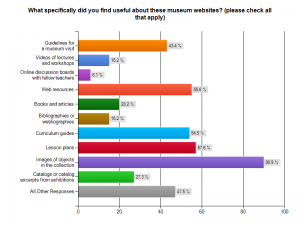Recently we teamed up with other museums throughout New York City and developed a survey to reveal what teachers thought about museum visitation and specifically, Museum Resources. While I understand the importance of museum resources and their creation is my main focus here at the Rubin Museum of Art, other people may not know what a “museum resource” actually is.
Resources may be defined as “a source of supply, support, or aid, especially one that can be readily drawn upon when needed.” As an important educational tool, museum resources allow teachers and everyday visitors to “draw upon” these additions to further the content of an art piece or historic artifact.
For teachers this support is especially important. With the help of expanding the content, teachers can create a whole new world filled with inquiry based questions allowing students to fully understand and experience the object being studied. But are teachers using them?
After asking this question to New York City teachers we found that 90% of responders use images from art museums to help with their lessons and say access to these and other resources on website are helpful. However, when asked if they use lesson plans created by museums 58.2% had stated they do. So why the sharp contrast?
To further our study, a focus group was held for teachers from different schools, backgrounds and subjects in which they teach. But one similarity between all of them is their adaptation of resources provided to them. On many occasions their response seemed to be that resources were extremely helpful but that due to class time, and curricular subject matter teachers may make small changes to fit their teaching style or classroom environment.
So how does a museum keep up with the classroom and create useful resources? The question will soon be discussed with a large group of educators at the upcoming 2011 NYCMER Conference. To learn more about the subject come join educators from the Rubin Museum along with other museums throughout the New York City region.



